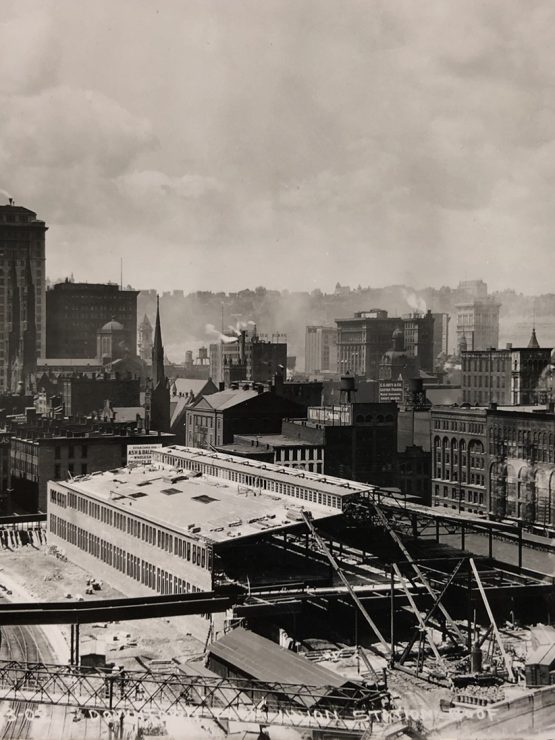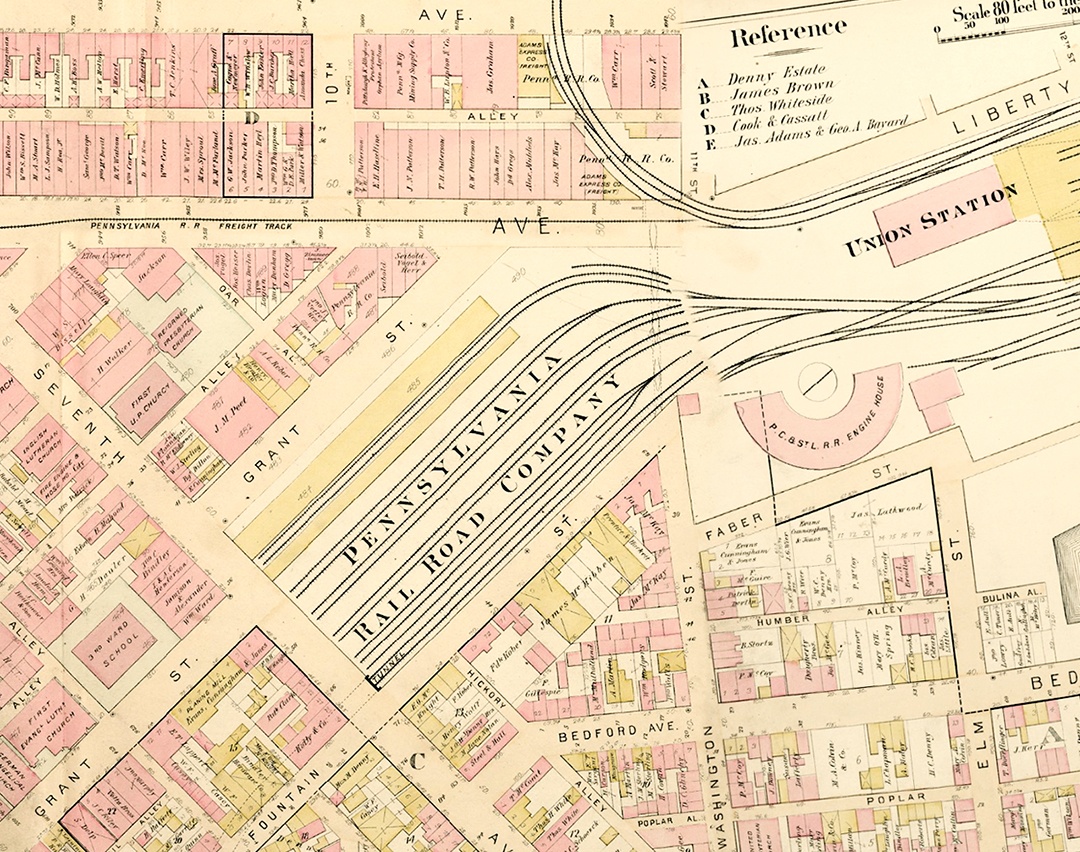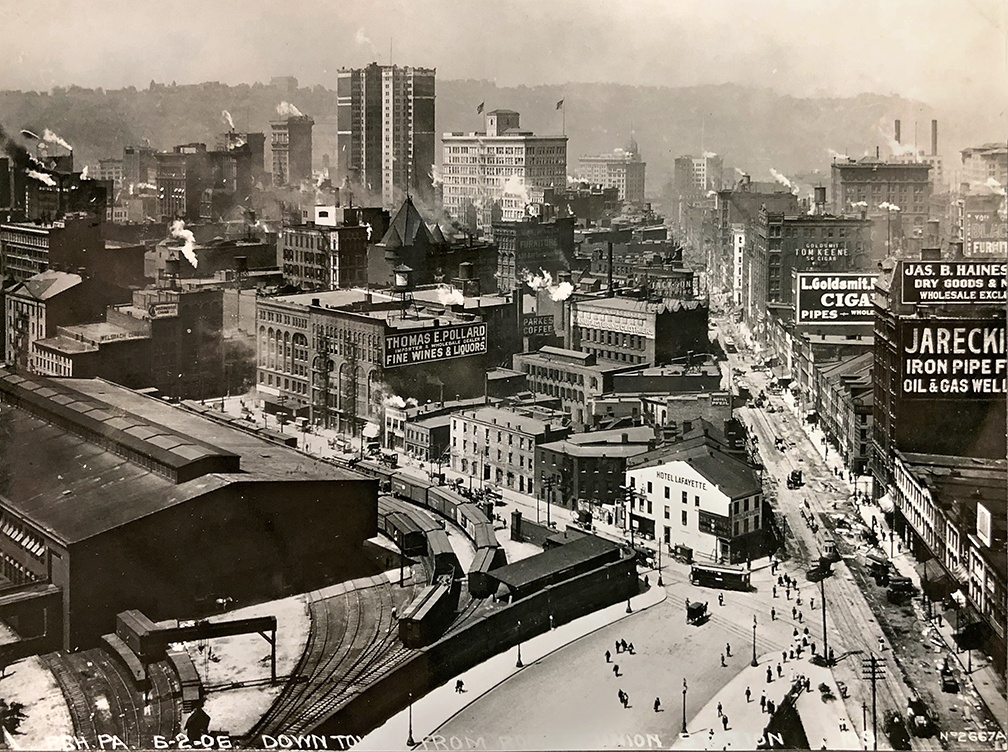
While the country plunged into the Great Depression, the eastern edge of downtown Pittsburgh was on the upswing. Newspapers of the late 1920s and early ’30s crowed that new construction on Grant Street made the area near the Pennsylvania Railroad (PRR) Station “one of the most valuable and important intersections in downtown Pittsburgh.”[1] The Koppers Building, Gulf Building, Federal Reserve Bank of Cleveland (now Drury Plaza Hotel), and block-long U.S. Post Office and Federal Courthouse (now Joseph F. Weis, Jr. U.S. Courthouse) all reinforced that Grant was “one of the city’s leading business streets.”[2]
The flurry of new construction was possible because that block of Grant Street was itself new. Before 1886, Grant had been a through street, meeting Liberty, like today, at 11th Street. That last block, ending at the PRR station, also had train tracks down both sides and a small depot to serve freight trains.[3] The PRR, however, needed more room, so in 1887, Grant was relocated a half-block north so the railroad could expand its freight station atop the street.[4]
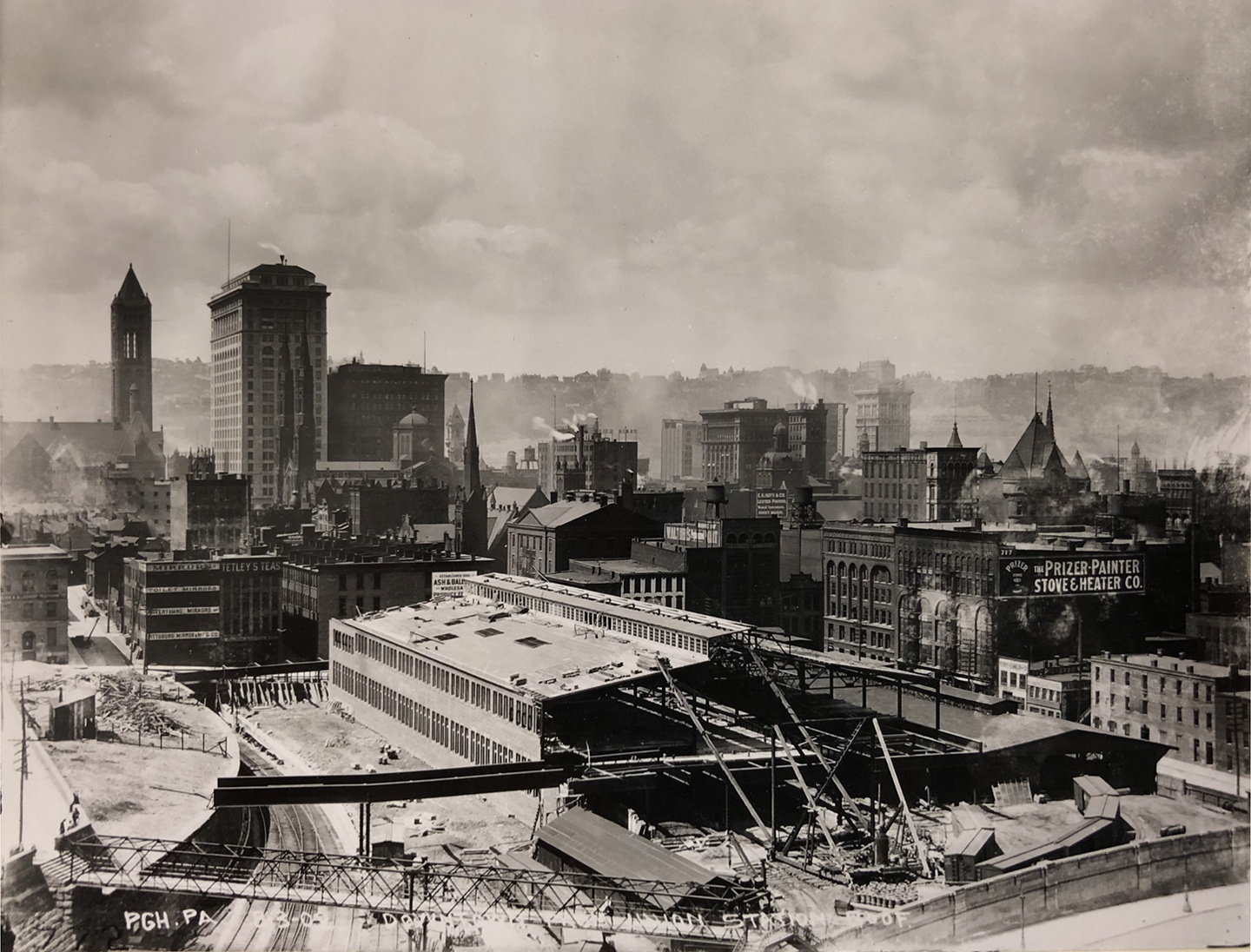
The result: eastbound traffic on Grant had to zig left on Seventh, zag right onto New Grant Street for a block until it reached Liberty Avenue, then zig back a block east to 11th—all to go around the railroad’s privileged freight yard.[5] New Grant, being squeezed in, was skinny with only one sidewalk and always jamming with wagon deliveries, leading one businessman to complain, “There are times when we might as well not have a street there at all… Let the company move back their sheds 10 or 12 feet or have a yard where the process of loading and unloading merchandise can be carried on.”[6]
After more than three decades of this jumbled layout, the PRR announced plans to relocate its freight operations, allowing Grant to be made whole again.[7] In 1925, the freight station was cut in half and inbound freight was moved to the Strip District at Penn Avenue and 16th Street. The remaining station was briefly used but finally abandoned by the PRR in 1926, when operations moved two blocks away to the Penn Avenue Freight Station at Penn and 11th.[8]
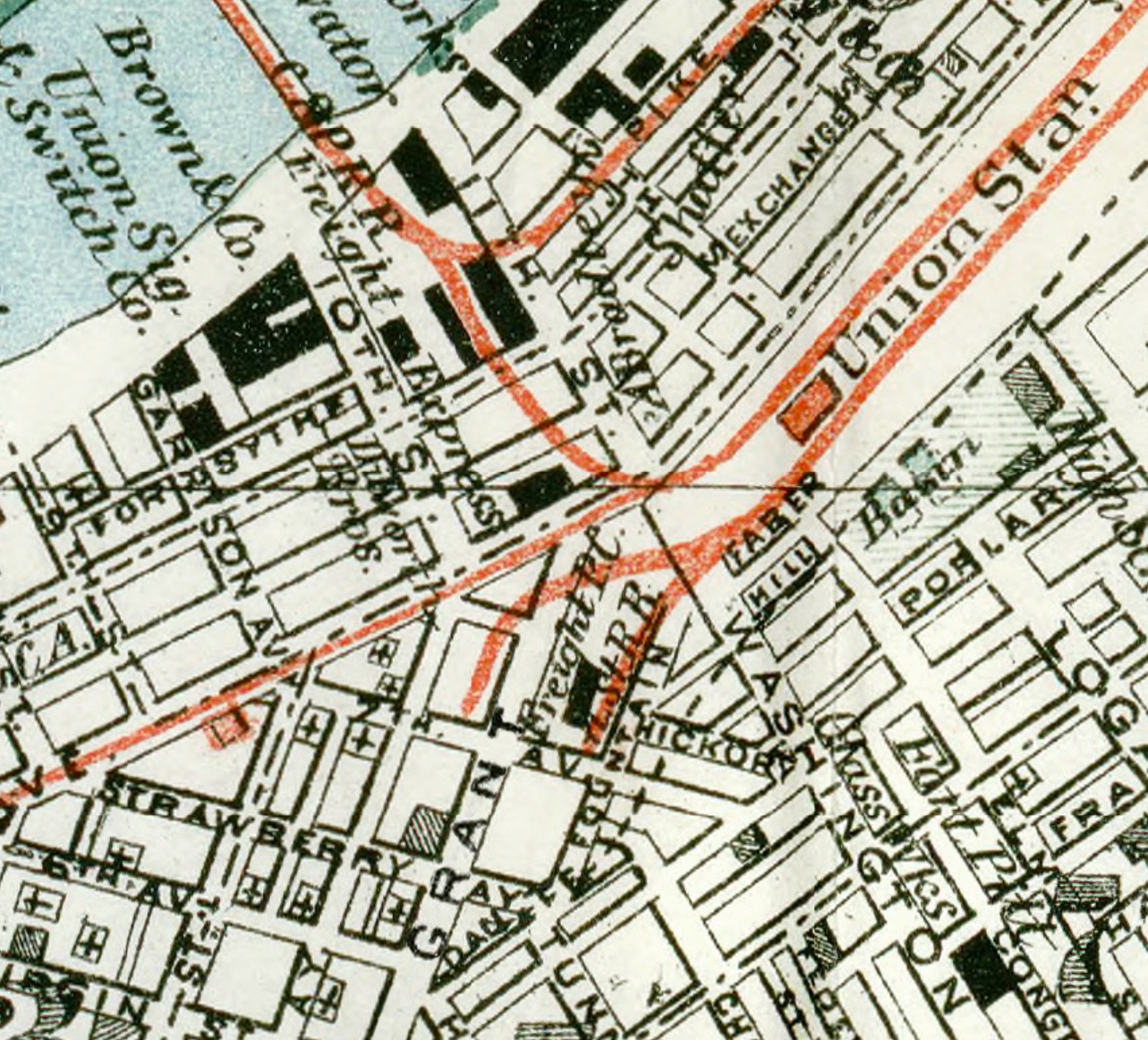
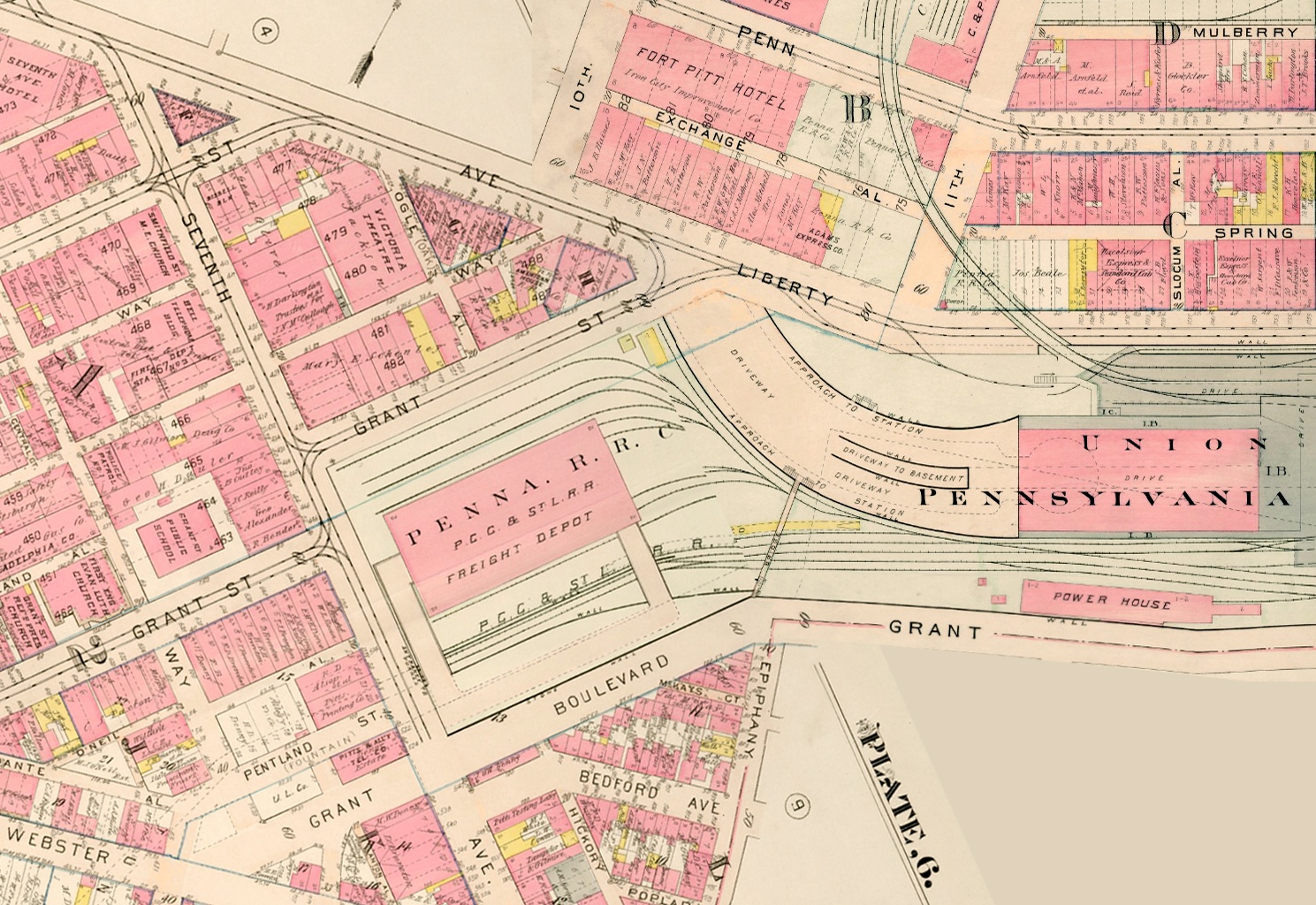
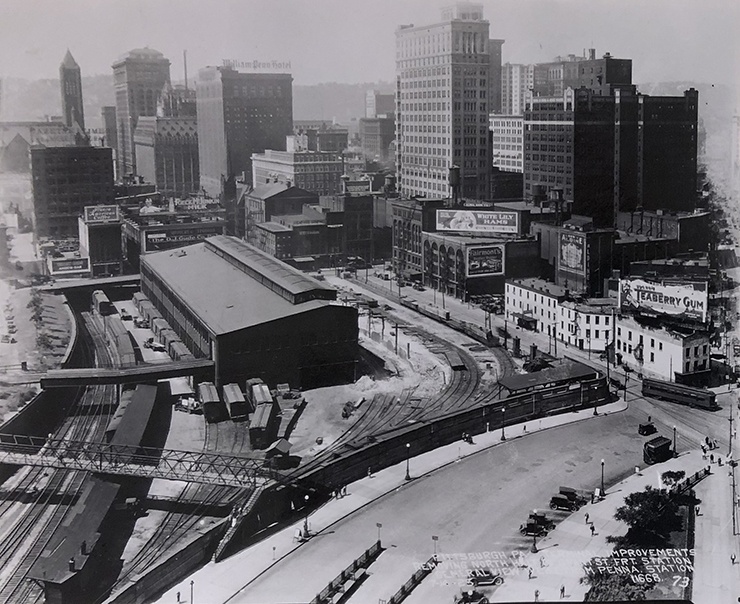
As Grant Street returned to its original straight alignment, the curved concourse of PRR’s passenger Station had to be trimmed back to allow Grant to (again) meet Liberty.[9] Grant was now 56 feet wide with 12-foot-wide sidewalks, and open land lined both sides of the new block.[10]
What followed in the next five years, as architectural historian Franklin Toker has written, was Andrew Mellon masterminding the construction of four major buildings at the corner of Grant and Seventh: Koppers on the east side of Seventh Avenue in 1929, Federal Reserve Bank of Cleveland in 1931,[11] Gulf Building on the west side of Seventh in 1932 (fittingly the site of the first U.S. oil refinery),[12] and the U.S. Post Office and Federal Courthouse in 1934.[13] Andrew and his brother Richard B. Mellon were chief shareholders in Koppers and Gulf, plus as U.S. Secretary of the Treasury, Andrew oversaw the other two buildings.[14] Today, the Koppers/Gulf/Federal Reserve buildings remain three of the city’s leading examples of art deco/moderne architecture.
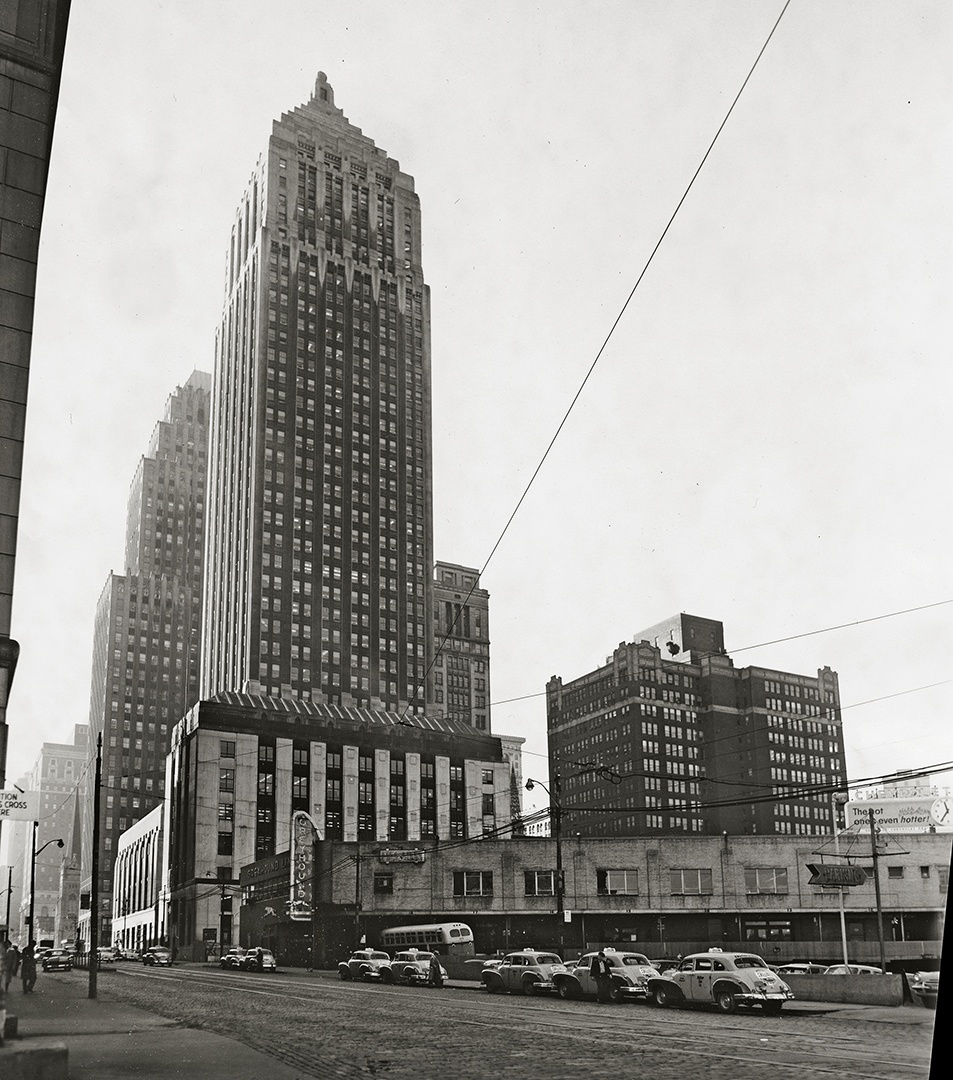
The Post Office/Courthouse was built on the site of the original (pre-1886) PRR freight station.[15] Andrew Mellon appropriated the money and helped choose the architects.[16] Dedicated Oct. 13, 1934, it ran the entire south side of the new block.[17] The new block was dazzling—except for a dreary lot next to the trio, a dirt strip filled with cars and idling buses lined up against the old Lafayette Hotel, which had been converted into a Greyhound bus station.[18]
With bus travel booming in the 1930s, it was obvious that Pittsburgh needed a larger, legitimate station, and the land around the old hotel-turned-depot was perfect for a new terminal. Look for that story in the sequel to this post, “Pittsburgh’s Streamline-Deco Greyhound Bus Station.”
[1] “Gulf Building to be the Highest,” Pittsburgh Press, January 11, 1931, p. 44.
[2] “P.R.R. Anxious to Start Huge Local Project: $15,000,000 Improvement Awaits Formal City Action,” Pittsburgh Gazette Times, May 25, 1925, p. 17. Also see “Grant St. Station to be Abandoned,” Pittsburgh Daily Post, May 28, 1925, p. 16.
[3] “A Hope Dispelled,” Pittsburgh Commercial Gazette, May 12, 1886, p. 3.
[4] “Volcanoes Turned Loose,” Pittsburgh Daily Post, March 29, 1888, p. 3. The PRR also built four bridges for the city and widened Cherry Alley, per “Widening Cherry Alley,” Pittsburgh Daily Post, June 16, 1887, p. 2. Decades earlier, another transit system plied this same block: the aqueduct of the Pennsylvania Canal made its way from the Allegheny to the Monongahela River. The takeover also meant cutting off Washington Street between the Hill District and Grant; in its place a pedestrian viaduct was built. All this work was done by renowned city contractor firm Booth and Flynn.
[5] The freight station was also known as the Panhandle Freight Station, the name derived from a PRR subsidiary that crossed the panhandle of West Virginia.
[6] “New Grant Street Again,” Pittsburgh Press, January 16, 1888, p. 8.
[7] “P.R.R. Moves to Spend Millions Here,” Pittsburgh Press, November 20, 1922, p. 1-2.
[8] “City Planners Propose Many Changes Here in Rail Routes,” Pittsburgh Gazette Times, March 10, 1924, p. 1. The plan was to build a new, larger station at the site of the old Schoenberger steel and wire mills between 14th-16th Streets.
[9] “P.R.R. $15,000,000 Program Described,” Pittsburgh Sunday Post, June 14, 1925, Sec. 4, p. 9; “P.R.R. Anxious to Start Huge Local Project: $15,000,000 Improvement Awaits Formal City Action,” Pittsburgh Gazette Times, May 25, 1925, p. 17. Also see “Grant St. Station to be Abandoned,” Pittsburgh Daily Post, May 28, 1925, p. 16.
[10] “P.R.R. to Start Big Downtown Improvement Work Monday,” Pittsburgh Daily Post, June 19, 1925, p. 2; “To Raze Pennsylvania Freight Station Monday,” Pittsburgh Gazette Times, June 19, 1925, p. 9; “Plans to Vacate Freight Station,” Pittsburgh Daily Post, November 20, 1926. According to “Panhandle Station Will be Abandoned,” Pittsburgh Daily Post, November 24, 1926, only then was the station to be abandoned, with work transferred two blocks away to the Penn Avenue Freight Station at Penn and 11th Street. The deed, taken over by the government, provided that the site be cleared by January 11, 1927; “Panhandle Station Being Demolished,” Pittsburgh Daily Post, January 12, 1927, p. 4.
[11] Learn more at www.druryhotels.com/content/historic-renovations-pittsburgh, acc. June 24, 2018. “Cleveland architecture firm Walker and Weeks designed the original Art Deco seven-story building, which opened in 1931 and features a Georgia marble building cover. A Pittsburgh architect, William York Cocken, added a 10-story addition in 1956, which is clad in limestone.”
[12] “Oil Co. Plans Big Building,” Pittsburgh Post-Gazette, February 28, 1929, p. 22; “Reserve Bank Contract Let,” Pittsburgh Post-Gazette, October 25, 1930, p. 19.
[13] “The Postoffice Question Again,” Pittsburgh Press, March 30, 1917, p. 26.
[14] Franklin Toker, Buildings of Pittsburgh (Charlottesville: University of Virginia Press, 2007), p. 36-38. Also see Louise King Sturgess, ed., Exploring Pittsburgh: A Downtown Walking Tour (Pittsburgh: PHLF, 2018), p. 27-34.
[15] “Federal Bank Site Sought,” Pittsburgh Post-Gazette, January 4, 1930, p. 2.
[16] Lu Donnelly, “Architecture Around Us: Pittsburgh’s Federal ‘Post Office, Courthouse and So Forth,’” Western Pennsylvania History, Fall 2006, p. 6-7. The building underwent a $73 million retro-fitting around 2004. It is now known as The William S. Moorhead Federal Office Building.
[17] Theodore A. Huntley, “New Post Office Here To Be Begun in 1929,” Pittsburgh Post-Gazette, December 30, 1927, p. 1, 5. The $5 million project, which replaced the old Federal building and post office on Smithfield Street, was one of the first big projects financed from $100 million authorized by Congress for public buildings outside the Capitol. The Pennsylvania Railroad spent $80,000 to clear the site and have it ready for March 1931, including relocating the Panhandle tracks, per “Orders Work on Post Office,” Pittsburgh Post-Gazette, February 7, 1931, p. 17. The Post Office closed and moved in 2014, and the building was renamed the next year for a decorated WWII veteran and Federal appellate judge, per Sturgess, Exploring Pittsburgh.
[18] Ad, “A New Bus Station in Pittsburgh for Greyhound Lines,” Pittsburgh Press, May 29, 1929, p. 17.
Look for Brian’s full story of Grant Street and Greyhound in the Spring 2019 Western Pennsylvania History magazine, available from the History Center’s Museum Shop or for purchase online.
Brian Butko is Director of Publications at the Heinz History Center, and author of books on diners, Isaly’s, Roadside Attractions, and Kennywood.

